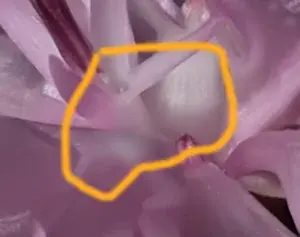407370
Been spending a lot of time on here!
- Joined
- Jan 18, 2014
- Messages
- 1,195
- Reaction score
- 847
- Location
- Sussex
- Can others edit my Photos
- Photos OK to edit
Hi all,
To set the scale I am working at, here is a pic of the flower next to my finger print:

I setup in my studio (garden shed) with a GODOX V1 as an off camera flash. I decided on this setup after much testing of various diffusors:


The subject flower is so small I thought I could get a sharp pic of the whole flower with a higher aperture (f40):

As you can see that did not work. I did try at f16 but it was not much better.
I started Focus stacking at f5.1 and 20 images:

Dont you love a good halo . I applied a 1 stop exposure compensation and tried again:
. I applied a 1 stop exposure compensation and tried again:

Halo not as obvious but still a bit unsharp.
So tried again with the following settings:
Aperture - F5
40 Image stack
Focus step - 1
Delay - 3 seconds
Exposure Compensation minus 1.7

Helicon Focus render settings:

Final result:

All in all a very informative little session.
Any and all comments welcome.
CHEERS
JBO
To set the scale I am working at, here is a pic of the flower next to my finger print:
I setup in my studio (garden shed) with a GODOX V1 as an off camera flash. I decided on this setup after much testing of various diffusors:
The subject flower is so small I thought I could get a sharp pic of the whole flower with a higher aperture (f40):
As you can see that did not work. I did try at f16 but it was not much better.
I started Focus stacking at f5.1 and 20 images:
Dont you love a good halo
 . I applied a 1 stop exposure compensation and tried again:
. I applied a 1 stop exposure compensation and tried again:Halo not as obvious but still a bit unsharp.
So tried again with the following settings:
Aperture - F5
40 Image stack
Focus step - 1
Delay - 3 seconds
Exposure Compensation minus 1.7
Helicon Focus render settings:
Final result:
All in all a very informative little session.
Any and all comments welcome.
CHEERS
JBO








![[No title]](/data/xfmg/thumbnail/39/39645-11fae384f9fd2ec2813acc42adec0206.jpg?1734173952)
![[No title]](/data/xfmg/thumbnail/41/41900-d02b27da6248f10da25edf2413570222.jpg?1734176254)
![[No title]](/data/xfmg/thumbnail/39/39497-93752210dd49247220721e5ac8c61245.jpg?1734173613)




![[No title]](/data/xfmg/thumbnail/35/35880-9a6926237907ab72b42781d9a09698a6.jpg?1734167640)